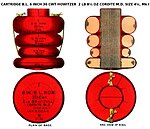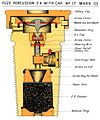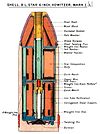| BL 6 inch 30 cwt Howitzer | |
|---|---|
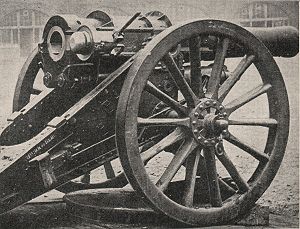 With breech open, circa. 1900 | |
| Type | Medium howitzer |
| Place of origin |
|
| Service history | |
| In service | 1896 - 1918 |
| Wars |
Second Boer War World War I Greco-Turkish War (1919–1922) |
| Production history | |
| No. built | 120 |
| Specifications | |
| Crew | 10 |
|
| |
| Shell |
Lyddite : 122 lb 9 oz (55.59 kg),[1] later 100 lb (45.36 kg);[2] Shrapnel : 100 lb (45.36 kg) |
| Calibre | 6-inch (152.4 mm) |
| Recoil | Hydro spring, 18 inch[3] |
| Carriage | Wheeled, box trail |
| Elevation |
-10° - 35° (wheeled carriage) 35° - 70° (siege mount)[3] |
| Muzzle velocity | 777 ft/s (237 m/s) [3] |
| Maximum firing range |
5,200 yds (122lb 9oz shell, on wheeled travelling carriage); 7,000 yds (122lb 9oz shell, on siege mounting) 7,000 yards (100 lb shell, on wheeled travelling carriage)[4] |
The Ordnance BL 6 inch 30cwt howitzer was a British medium howitzer used in the Second Boer War and early in World War I. The qualifier "30cwt" refers to the weight of the barrel and breech together which weighed 30 hundredweight (cwt) : 30 x 112 lb = 3360 lb. It can be identified by the slightly flared shape of the muzzle and large recuperator springs below the barrel.
History[]
Introduced 1896, based on an Indian Army design.
Its original shell was 122 lb 9 oz Lyddite explosive. In 1901 a lighter 100 lb (45 kg) shell was introduced which increased maximum range when firing from its wheeled travelling carriage to 7000 yards.[5] These were then referred to as the "heavy" and "light" shell respectively. A 100 lb shrapnel shell was also available.
It was phased out and replaced by 6 inch 26 cwt howitzer from late 1915 onwards.
Combat use[]

This gun was designed as a siege howitzer firing a special 122 pounds 9 ounces (55.59 kg) howitzer shell. It was designed to be fired from a static siege platform, with wheels removed, for accurate long-range shooting. When fired mounted on its normal wheeled travelling carriage, which had become standard practice for modern medium artillery, its range and accuracy diminished due to limited elevation and also lack of a modern recoil mechanism.
Second Boer War[]

12 Guns were employed in South Africa in the Second Boer War as part of the British siege train. It was during this campaign that the short range limitation became evident, and shell weight was traded for greater range in 1901 with the introduction of a "light" 100 pounds (45.36 kg) shell which increased maximum range when firing from its wheeled travelling carriage to 7000 yards. No use was found for the siege platform which allowed elevation to 70° : "This capability was designed for distinct siege operation, and in South Africa the need for this did not arise. In this theatre the platform was an encumbrance, and it was discovered that it could be dispensed with".[5]
World War I[]

When World War I began approximately 80 guns were still available. They constituted the only true heavy artillery the British army possessed, and were heavily engaged in the early battles in France and Flanders. It was adapted to use the standard 100 pounds (45.36 kg) gun shell, with a slight enlargement of the chamber to produce Mk I*, allowing slightly larger propellant charges.[6] It served in all theatres, including the Western Front, until replaced by the modern 6 inch 26 cwt howitzer from late 1915. However, Gallipoli was given low priority for modern ordnance and the 6 inch 30 cwt was used by 14th Siege Battery RGA (4 guns), attached to 29th Division, at Helles, and by the Australian 1st Heavy Artillery Battery (2 guns from the Royal Malta Artillery, crewed by the Royal Marine Artillery, which arrived in May[7]) at Anzac.
Greco-Turkish War (1919–1922)[]
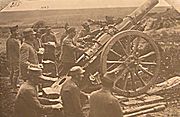
Judging by official Greek photographs and text, at least one howitzer was deployed by Greece during the Greco-Turkish War of 1919 – 1922.
World War I ammunition[]
One or more rings were removed for shorter ranges. |
Operators[]
Australia - 2 pieces, 1st Heavy Artillery Battery (see Ross Mallett, AIF 1914-1918 Artillery & 2. Gallipoli)
United Kingdom - Royal Garrison Artillery (amalgamated in 1924 into Royal Artillery
See also[]
- 6 inch 26 cwt howitzer : British Empire successor
- List of howitzers
Weapons of comparable role, performance and era[]
- 15 cm schwere Feldhaubitze M 94 : Austro-Hungarian equivalent
- 15 cm sFH 02 : German equivalent
Surviving examples[]

- A gun at Royal Artillery Museum, Woolwich, London
- A gun at the Imperial War Museum, Duxford, UK
- A gun at the War Museum of Athens, Greece
- A gun at the War Museum, Salonica, Greece

Gun at the War Museum, Salonica, Greece
Notes and references[]
- ↑ Text Book of Gunnery 1902, Table XII Page 336
- ↑ Treatise on Ammunition, 10th Edition, 1915
- ↑ 3.0 3.1 3.2 Hogg & Thurston 1972, page 125
- ↑ Clarke 2005, page 20
- ↑ 5.0 5.1 Hall June 1972
- ↑ Treatise on Ammunition, 1915. Page 95. War Office.
- ↑ CEW Bean,"THE OFFICIAL HISTORY OF AUSTRALIA IN THE WAR OF 1914-1918 Volume II" page 80. 11th Edition, published by Angus & Robertson, Sydney, 1941
Bibliography[]
- Text Book of Gunnery, 1902. LONDON : PRINTED FOR HIS MAJESTY'S STATIONERY OFFICE, BY HARRISON AND SONS, ST. MARTIN'S LANE
- Dale Clarke, British Artillery 1914-1919. Heavy Artillery. Osprey Publishing, Oxford UK, 2005 ISBN 1-84176-788-3
- I.V. Hogg & L.F. Thurston, British Artillery Weapons & Ammunition 1914-1918. London: Ian Allan, 1972. ISBN 978-0-7110-0381-1
- Major Darrel Hall, "Guns in South Africa 1899-1902 Part V and VI" in The South African Military History Society Military History Journal - Vol 2 No 3, June 1972
External links[]
| Wikimedia Commons has media related to BL 6 inch 30 cwt Howitzer. |
| |||||||||||||||||||||||||||||||
The original article can be found at BL 6-inch 30 cwt howitzer and the edit history here.
